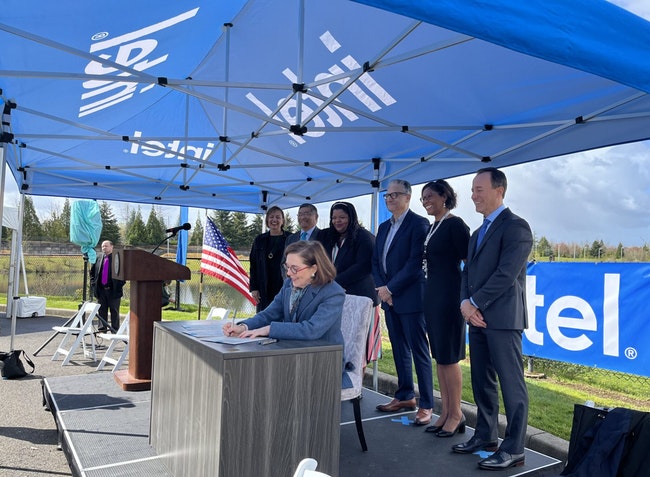
Gov. Kate Brown signs her $200 million “Future Ready Oregon” workforce spending plan at the Intel campus in Hillsboro, Oregon, on April 5, 2022. (Julia Shumway/Oregon Capital Chronicle)
HILLSBORO – Gov. Kate Brown on Tuesday signed into law a $200 million workforce spending plan aimed at helping more Oregonians find good-paying jobs in health care, manufacturing and construction.
The plan, dubbed “Future Ready Oregon,” is likely Brown’s final legislative victory before she departs the governor’s office in January. It will result in a skilled workforce and brighter prospects for working families, she said as she signed the bill at Intel’s Hillsboro campus.
“As the state of Oregon writes its next chapter, we must ensure that every Oregonian regardless of their race, gender, income, faith, zip code or lack thereof has the opportunity to thrive,” she said.
Dozens of legislators, business leaders and people who worked on the spending package surrounded Brown as she signed the bill under an Intel-branded tent. Job training funded by the new law could prepare Oregonians for work at Intel, which manufactures microprocessor chips and is the largest employer in the Portland metro area with about 20,000 employees.
“We are excited about Future Ready Oregon as an investment in Oregonians and future Intel talent,” said Jeff Birdsall, the company’s vice president of technology development.
Some onlookers shivered during the hour-long outdoor ceremony, and Brown revised her prepared comments to acknowledge the chilly spring weather.
“If it was a little warmer out, we could roll up our sleeves and get to work to build a skilled and diverse workforce,” Brown said.
The plan, which was developed primarily by Brown’s Racial Justice Council, is targeted at people of color, women and people who live in rural communities or have low incomes. About $120 million of the $200 million came from federal funding through the 2021 American Rescue Plan Act, with the state picking up the rest.
It includes:
-$95 million for community organizations to distribute to workers to subsidize costs like child care, housing and transportation as they learn new skills.
-$35 million for local workforce boards to recruit and train workers.
-$20 million for apprenticeship programs at the state Bureau of Labor and Industries.
-$15 million for career programs at community colleges.
-$10.5 million for the Oregon Department of Education to help young people gain paid work experience or train for jobs.
-$10 million in grants to community colleges to develop more opportunities for students to earn academic credit for skills they learned outside of school.
-$10 million for local workforce boards to connect people seeking jobs with other benefits for which they might qualify.
Patsy Richards, who runs an apprenticeship program for certified nursing assistants and co-chaired the group that developed the plan, said it will help people find and keep jobs.
“There are not only barriers to entry,” Richards said. “There are barriers to retention.”
She provided legislators examples of those barriers during committee hearings earlier this year. One member of her apprenticeship program couldn’t afford new scrubs, and she realized clothing and tools were something apprenticeship programs could provide for people to complete their training. And even parents who qualify for subsidized child care may be dissuaded from working if their salaries aren’t high enough to cover the remaining costs of child care.
Brown said the plan requires a shift to thinking about child care as necessary. A separate $1.2 billion spending package she signed earlier this month provides about $100 million to increase the amount the state pays to subsidize child care for low-income families, recruit and train more child care providers and help existing facilities expand.
“Approaching workforce development with an equity lens really is the heart and soul of this legislation,” she said. “This means identifying barriers to career advancement for underserved communities, providing support services to help individuals overcome those barriers, and viewing these supports –such as child care access, or broadband – as critical infrastructure.”
Brown said Oregon will start seeing effects of the new funding immediately. For instance, Oregon Tradeswomen, one of the groups that collaborated on the spending plan and will likely receive money from it, has provided career training and other resources for about 1,000 women annually in recent years with a roughly $2 million budget.
“This will enable a program like Oregon Tradeswomen to double or triple their capacity,” Brown said. “These women leave the program going into apprenticeship programs around the state. I think you’re going to see the impacts immediately.”
Oregon Capital Chronicle is part of States Newsroom, a network of news bureaus supported by grants and a coalition of donors as a 501c(3) public charity. Oregon Capital Chronicle maintains editorial independence. Contact Editor Les Zaitz for questions: [email protected]. Follow Oregon Capital Chronicle on Facebook and Twitter.
STORY TIP OR IDEA? Send an email to Salem Reporter’s news team: [email protected].









